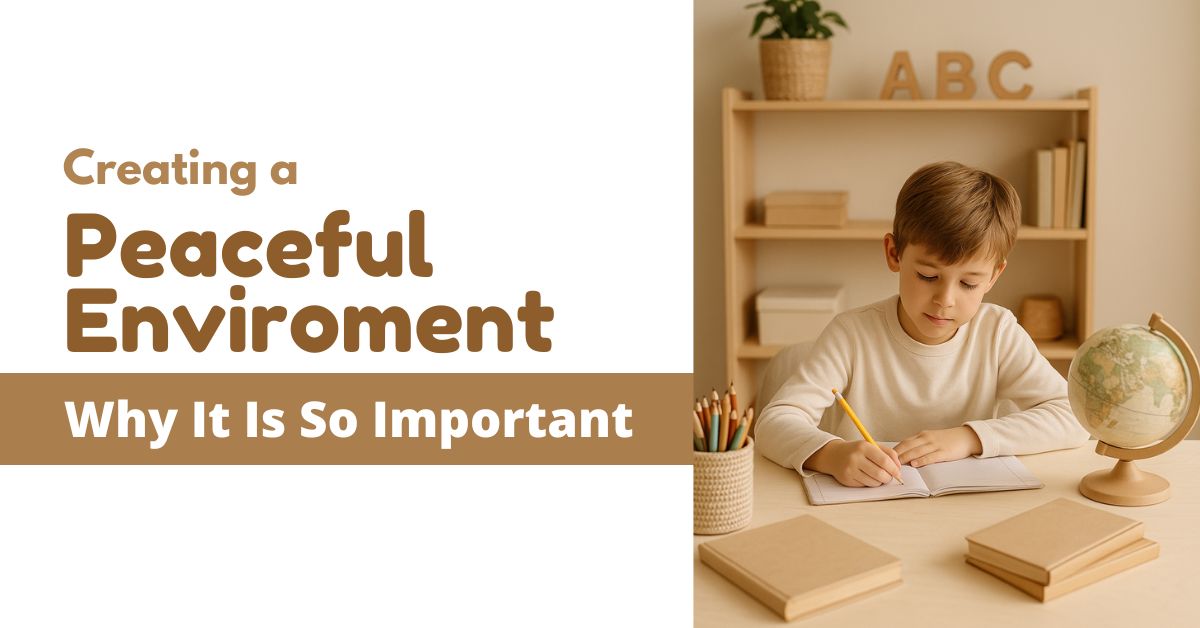Let’s be honest, when you pictured homeschooling, you probably imagined quiet mornings with children eagerly hunched over their books, the soft scratch of a pencil on paper, and maybe a gentle classical tune playing in the background. Then reality hit. Some days, it feels less like a serene educational haven and more like a three-ring circus where you’re the slightly frazzled ringmaster. If this sounds familiar, you’re not alone! Creating a tranquil learning space is one of the most common challenges for homeschool parents. The good news is that with a few key peaceful homeschool environment tips, you can transform the chaos into calm and foster a space where your child can truly thrive.
So, why does this matter so much? A peaceful environment isn’t just about making your day less stressful (though that’s a huge perk!). For a child, a calm and predictable space is foundational to their ability to learn. When a child feels safe, secure, and relaxed, their brain is better equipped to absorb new information, think critically, and engage creatively. Constant noise, clutter, and emotional tension can trigger a “fight or flight” response, making it nearly impossible for them to focus on algebra or ancient history.
By prioritizing peace, you are directly investing in your child’s academic success and emotional well-being.
The Brain Science Behind Calm Learning
It might sound a bit dramatic, but stress is the enemy of learning. When a child is anxious or overwhelmed, their body releases cortisol, the stress hormone. High levels of cortisol can impair memory and cognitive function. Think about a time you were incredibly stressed—was it easy to concentrate on a complex task? Probably not. The same is true for our kids. A calm learning space minimizes these stressors, allowing the prefrontal cortex—the part of the brain responsible for problem-solving, planning, and focus—to do its job without interference.
This doesn’t mean your house needs to be silent as a library 24/7. It’s about creating an atmosphere of emotional safety and physical order. When children know what to expect and feel emotionally supported, they are free to be curious and take intellectual risks. A peaceful environment signals to their nervous system that it’s safe to relax, explore, and, most importantly, learn.
Stress-Free Homeschooling Strategies For Parents
Before we can create a calm space for our kids, we often need to start with ourselves. Our children are emotional sponges, and if we’re radiating stress, they will soak it right up. Managing your own well-being is not selfish; it’s a critical part of a successful homeschool strategy.
Here are some practical strategies to keep your own stress levels in check:
- Simplify Your Curriculum: Don’t fall into the trap of trying to do it all. It’s better to cover a few subjects deeply and joyfully than to rush through a dozen subjects with stress and frustration. If a particular curriculum is causing tears (for you or your child), it’s okay to put it aside and try something else.
- Embrace Flexibility: One of the greatest benefits of homeschooling is the ability to create a schedule that works for your family. If everyone is tired and cranky on a Tuesday morning, maybe that’s the perfect time for an impromptu nature walk or a documentary on the couch. Learning happens everywhere, not just at a desk between 9 AM and 3 PM.
- Set Realistic Expectations: Your homeschool will not look like the perfect pictures you see on social media. There will be messy days, unproductive days, and days when you question every decision you’ve ever made. That is normal. Focus on progress, not perfection.
- Schedule “You” Time: You cannot pour from an empty cup. Whether it’s waking up 30 minutes before the kids for a quiet cup of coffee, scheduling a regular walk with a friend, or locking the bathroom door for a 15-minute soak, find small ways to recharge your own batteries every single day.

Designing Calm Learning Spaces For Kids
Now let’s talk about the physical environment. You don’t need a dedicated, professionally designed schoolroom to create a calm learning space. A quiet corner of the living room or a small desk in a bedroom can work just as well. The key is to make the space intentional and inviting.
Think about what makes you feel calm. Is it soft lighting? Minimal clutter? Natural elements? Your child will likely respond to these same things. Work together to design a space that feels good to both of you.
1. Declutter Relentlessly: Visual clutter is a major source of distraction and anxiety. Keep the immediate learning area tidy and organized. Use bins, shelves, and baskets to give everything a home. At the end of each school day, take five minutes to reset the space together.
2. Incorporate Nature: Bringing elements of the outdoors inside has a proven calming effect. A small plant on the desk, a vase of fresh flowers, or even a window with a view of the trees can make a significant difference.
3. Mind the Senses: Consider all five senses when designing the space.
- Sight: Use a calming color palette. Soft blues, greens, and neutral tones are known to be soothing. Avoid overly bright or chaotic patterns.
- Sound: Minimize background noise. If you live in a noisy area, consider a white noise machine or playing soft, instrumental music.
- Smell: A gentle scent from a diffuser with lavender or chamomile essential oils can promote relaxation.
- Touch: Include comfortable seating and soft textures, like a cozy blanket or a small rug.
- Taste: Keep a water bottle and healthy snacks nearby to avoid disruptions caused by hunger or thirst.
4. Define the Space: Even if you don’t have a separate room, you can create a defined learning zone. Use a rug, a bookshelf, or even a folding screen to visually separate the “school” area from the rest of the home. This helps children transition mentally into “learning mode” and then switch off at the end of the day.
Peaceful Homeschool Environment Tips: Putting It All Together
So, how do we blend these elements—a calm parent, a calm physical space, and calm routines—into a cohesive whole? It comes down to rhythm and relationships. Children thrive on predictability. A gentle, consistent daily rhythm provides a sense of security that reduces anxiety and power struggles. This doesn’t mean a rigid, minute-by-minute schedule. A rhythm is more like a predictable flow to your day: morning quiet time, followed by focused academic work, then outdoor play, lunch, and creative projects in the afternoon.
This rhythm should be built around connection. Start the day with a snuggle on the couch, not with a command to get out the math book. Take breaks to read a chapter of a beloved book aloud. Check in with your child emotionally. Ask them how they are feeling about their work and what they are enjoying. When the relationship is strong and secure, the learning will naturally follow. A peaceful homeschool is not about eliminating all challenges; it’s about creating a supportive and loving foundation from which to meet those challenges together.
The emotional tone of your homeschool is far more important than any curriculum you could buy or any organizational system you could implement. Laughter, patience, and grace are your most powerful teaching tools. When you model a calm and positive approach to challenges, you are teaching your child invaluable life lessons about resilience and emotional regulation. Remember that you are not just teaching subjects; you are raising a human being. The peaceful environment you cultivate will shape not only their education but also their character.
Explore More Homeschool Resources
Building a peaceful and effective homeschool environment is a journey, not a destination. There will be wonderful days and challenging ones, but every step you take toward creating a calm and connected atmosphere is a gift to your child. Remember to be patient with yourself and celebrate the small victories along the way.
Are you looking for more practical advice, curriculum reviews, and encouragement for your homeschool journey? Dive into our other articles! We at DKM Homeschool Resource are here to support you with a wealth of information to help you and your children thrive.




